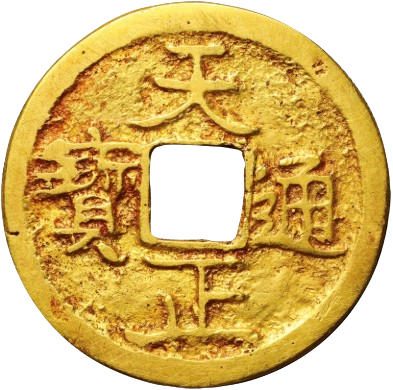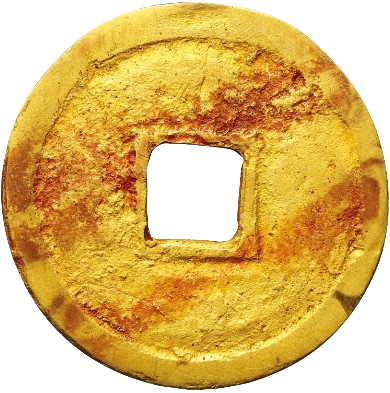Tenshō Tsūhō Kin
(天正通宝金)


(Ginza Coins Collection, Tokyo. Reproduction authorized. © All rights reserved.)
The Tenshō Tsūhō Kin represents a significant testament to the economic reforms enacted by Toyotomi Hideyoshi during the Tenshō period (1573–1592). Issued in 1587, these coins were primarily employed as rewards for loyal samurai and daimyō, thereby reinforcing political allegiance and central control. Weighing 5.4 grams and measuring 2.3 cm in diameter, they bore the inscription 天正通宝 (Tenshō Tsūhō) on the obverse, while the reverse remained unmarked, reflecting a sober and functional design. Crafted from gilded copper, their value was more symbolic than commercial. Although also intended for civilian circulation, their usage remained limited due to their high value. These coins formed part of Hideyoshi’s broader initiative to centralize authority and construct a unified economic identity.
| Coin Name | Tenshō Tsūhō Kin |
| Japanese Inscription | 天正通宝金 |
| Historical Period | Tenshō Period (1573–1592 d.C.) |
| Year of Minting | 1587 d.c. |
| Chronological Reference | Unspecified |
| Minting Location | Unspecified |
| Issuing Authority | Toyotomi Hideyoshi |
| Function | A symbolic reward for loyal samurai and daimyō; its circulation as currency remained limited. |
| Material | Gold (gilded copper alloy) |
| Shape | Circular |
| Height | 2.3 cm |
| Width | 2.3 cm |
| Weight | 5.4 g |
| Manufacturing Technique | Manually executed casting and striking performed on stone surfaces |
| Obverse Text and Symbols | Inscribed with 天正通宝Tenshō Tsūhō) |
| Reverse Text and Symbols | None |
| Calligrapher / Artist: | Unspecified |
| Museum References | Currency Museum Bank of Japan ⅡAカマa2 9-1/1 |
| Number of Known Specimens | Numerous known specimens (not precisely quantified) |
Sources and Bibliography
The Gold of Tokugawa, Alberto Rolfini 2025
瀧澤武雄, 貨幣 Takizawa Takeo, Kahei Nipponshi sho Hyakka 1999
